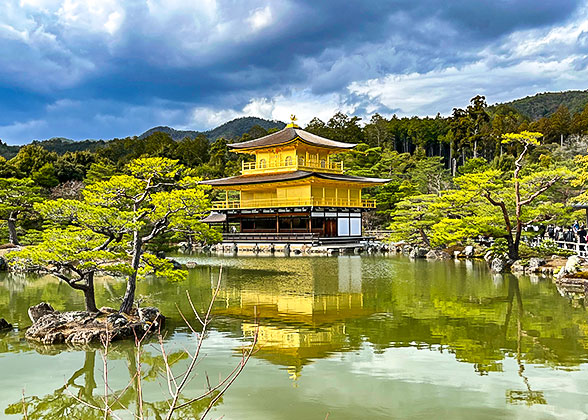Kinkaku-ji Temple (Temple of the Golden Pavilion)

Kinkaku-ji Temple Photos ( 26
|
History of Kinkaku-ji Temple
Speaking of Kinkaku-ji Temple, we must mention a figure called Ashikaga Yoshimitsu (1358-1408), the third shogun of the Muromachi period (1392-1573). Rokuon-ji, the temple’s official name, was derived from his posthumous name Rokuon-in. Once the private villa of Yoshimitsu built in 1397, it was converted to a Zen temple according to his will after his death at 51. 11 years of the Onin War - the civil war from 1467 to 1477 – had razed most of the temples’ buildings. The Golden Pavilion, though a survivor of the war, also failed to escape its fate of being destroyed in 1950 by a fire. Thanks to three decades of restoration efforts, the Pavilion presents its grandeur again before our eyes.Kinkaku-ji Temple also stood witness to Japan’s incorporating Ming-dynasty Chinese culture to its own society, as it was the place where Yoshimitsu negotiated trade affairs with Chinese official emissaries at that time.
|
|
|
Kinkaku, the Golden Pavilion and Relics Hall
Kinkaku, or the Golden Pavilion, is where the relics of Buddha are stored in the Kinkaku-ji Temple. 12.5 meters (41 feet) high, the Pavilion has three stories, with the top two gilded with gold. Interestingly, the three floors have different architectural styles and serve different functions.

The graceful Golden Pavilion
|
Hossui-in, the first floor
The first floor is called Hossui-in, meaning “the yard of dharma”. It was the wooden residential hall of Yoshimitsu, offering an insight into Japan’s old aristocratic lifestyle. Inside sit two statues next to each other, one of Shaka Buddha and another of Yoshimitsu. It’s not allowed to enter the building for preservation purpose, but the sliding door is often left open to spot them from across a pond, namely the Kyoko-chi Pond.Kinkaku-ji Temple
Cho’on-do, the second floor
Cho’on-do, literally “the cave of sound of waves”, can be understood as the place of Buddhist chanting. The exterior, including the rail, is completely covered with gold leaf. Inside the walls, there is a sitting statue of Kannon Bodhisattva, with Four Heavenly Kings standing by it. The space is even more mysterious with interior walls and floor lacquered in black, as well as flying Buddhist gods and a phoenix painted on different ceilings.Kukkyo-cho, the top floor
Kukkyo, “ultimate” or “apex” in English, is the name of the top floor. Not only the exterior, but also the interior ceiling and walls, are all gold-leafed. As gold stands for spiritual purity in Buddhism, it’s natural to see a Buddhist relic covered so extravagantly in gold. Stored inside is the sacred relic of Buddha, and perching on the outside top of the roof is a gold phoenix - the incarnation of Nirvana.Other Fascinating Sites at Kinkaku-ji Temple
Kyoko-chi Pond, which the Golden Pavilion overlooks
Covering 6,600 square meters (1.6 acres), Kyoko-chi Pond, with surrounding greenness and the Golden Pavilion overlooking it, makes up the most iconic sight of Kinkaku-ji Temple. It’s said the pond was constructed in the concept of the Lotus Pond of the Pure Land, where a lotus grows each time for a person when he/she does good. Several islets and rock formations embellish the rippled water, with trees growing on some giving life to the pond.
Rikusyunomatsu, the pine tree of Yoshimitsu
To the east of the Golden Pavilion stands a pine tree named Rikusyunomatsu. It’s said to be planted by Shogun Yoshimitsu himself, so it’s approximately more than 600 years old.Gingasen and Gankasui, water used by Yoshimitsu
Gingasen means "Milky Way Spring”, and Gankasui “Water Below Rock”. Legend has it that Yoshimitsu used the water of Gingasen to make tea, and that of Gankasui to wash his hands. You can still expect crystal-clear water from Gingasen even today.Anmintaku, possibly the source of Kyoko-chi Pond
Far to the northeast of the Golden Pavilion lies the pond of Anmintaku, which is considered the source of Kyoko-chi Pond. On the islet in the center stands a mini stone pagoda, called Hakuja-cho, or White Snake Mound, enshrining the guardian deity of the Saionji family, who transferred this land to Yoshimitsu.Sekkatei, the pavilion to see beautiful sunset
To the east of the Anmintaku pond sits a simple wooden pavilion called Sekkatei, meaning Evening-Sun Stop. It was once serving as a tea room while the Golden Pavilion was under restoration. From here, you can view a great sunset with the Golden Pavilion in the foreground.Opening Hours and Fee
Open: 9:00 am – 5:00 pm, all year aroundEntrance Fee: 500 yen
How to Get There?
Take Kyoto City Bus No. 205 from Kyoto Station, get off at the Kinkakuji-michi stop, and walk a few minutes.
Kinkaku-ji Temple Photos & Videos
You May Like
-
6 Days Group Tour of Tokyo - Mt. Fuji - Nagoya - Kyoto - Nara - Osaka from USD1509
-
14 Days Tokyo - Kamakura - Tokyo - Mt. Fuji - Hakone - Kyoto - Nara - Hiroshima - Osaka from USD3653
-
6 Days Luxuxy Tour of Tokyo - Mt. Fuji - Hakone - Kyoto - Osaka from USD3169
-
7 Days Private Tour of Tokyo - Mt. Fuji - Tokyo - Kyoto - Nara - Osaka from USD2024